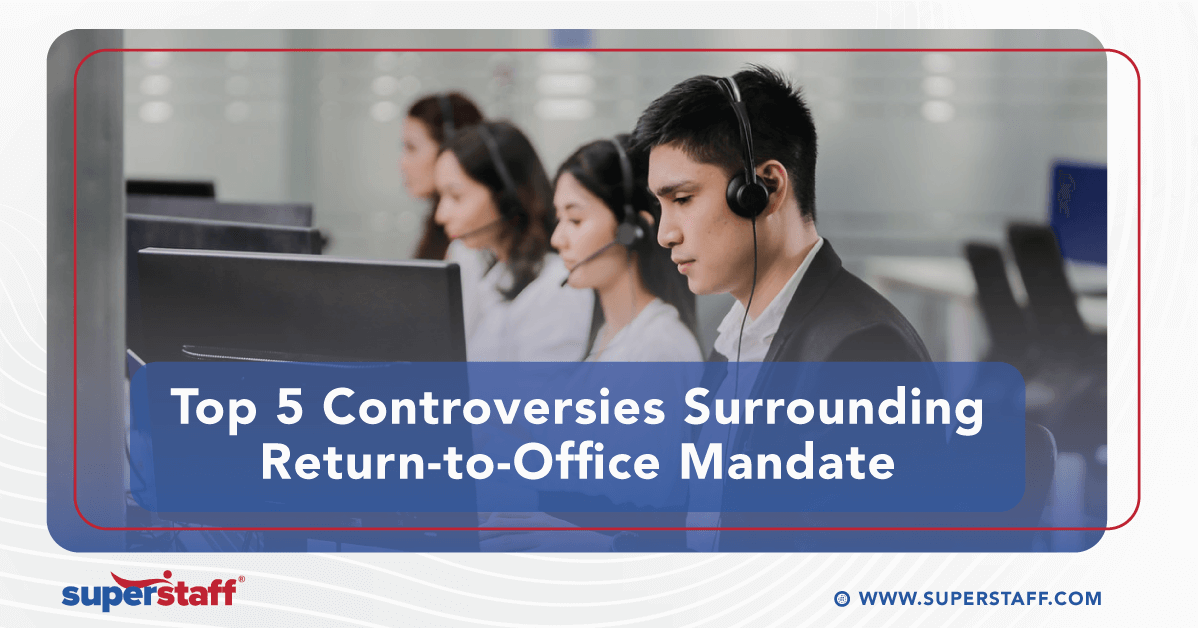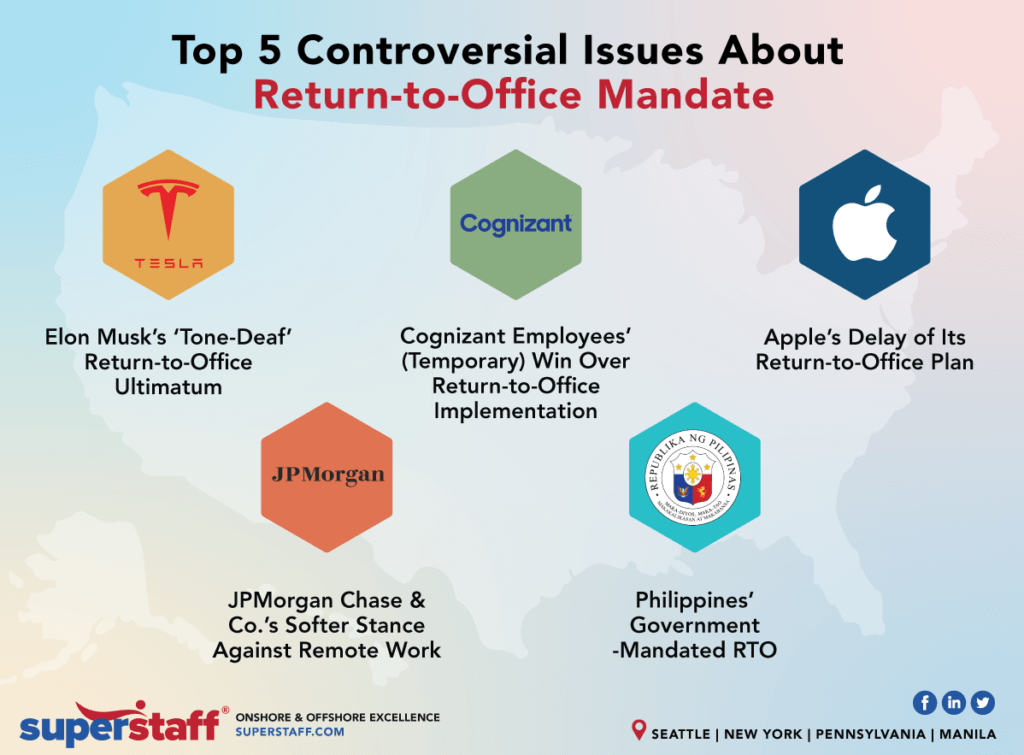
The return-to-office mandate has been triggering controversial debates among workers and employers. Disagreements have even dominated headlines.
Companies that were first adamant about their return-to-office mandate — even giving workers an ultimatum — have loosened up following strong resistance from employees. Some have indefinitely dropped, delayed, or scrapped the order. Only a few have remained committed to putting their foot down despite the threat of “The Great Resignation.”
By the looks of our newsfeeds — at least in the first half of 2022 — debates will not subside soon, especially since the labor market gives employees their long overdue bargaining powers.
If you find yourself lost with what the online chatters are all about, this article will help you jump into the conversations. Stay in the loop as we’ve rounded up five of the most controversial developments on returning to the office.
5 Headline-Grabbing Controversies Involving the Return-to-Office Mandate
1. Elon Musk’s ‘Tone-Deaf’ Return-to-Office Ultimatum
Forbes 2022’s top billionaire is always in the news. His latest squabble with critics is the return-to-office ultimatum he gave Tesla and SpaceX employees.
In a memo addressed to “Everyone” at Tesla, Elon Musk sternly told his executives to report to the office full-time or go look for another job elsewhere.
“Everyone at Tesla is required to spend at least 40 hours in the office per week,” Musk wrote in a message addressed to employees of the electric-car maker.
“Moreover, the office must be where your actual coworkers are located, there should be no remote pseudo-office. If you don’t show up, we’ll assume you’ve resigned. The senior you are, the more visible your presence.”
Musk’s stance against remote working is equally — or perhaps even more — controversial. In another email sent to Tesla employees, he went as far as questioning the performance of companies adopting more flexible working arrangements.
“There are, of course, companies that don’t require this, but when was the last time they shipped a great new product? It’s been a while.”
“Tesla has and will create and actually manufacture the most exciting and meaningful products of any company on Earth. This will not happen by phoning it in.”
Industry observers and business leaders warn that Musk’s statements could backfire and cause a talent stampede in Tesla, as seen in other organizations. But given Musk’s relentless determination, he will unlikely recant his return-to-office ultimatum.
Case in point: In June 2022, SpaceX fired employees who wrote and circulated an open letter criticizing Musks’ public behavior, calling it a “frequent source of distraction and embarrassment.”
Musk’s firm return-to-office stance has also caused distraught among Twitter employees. The company that Musk aspires to acquire has allowed its employees to work remotely indefinitely. During a virtual town hall with Twitter employees, Musk addressed the issue and said:
“If someone can only work remotely, and they’re exceptional, it wouldn’t make sense to fire them.”
Will this statement hold true in the future? With Elon Musk, we can only wait and see.
2. Cognizant Employees’ (Temporary) Win Over Return-to-Office Implementation
Another company that gave its employees a return-to-office ultimatum is Cognizant. The company initially announced that three days after June 6, 2022, any one who would not report to the office five days a week would be flagged for job abandonment.
However, after resistance from its Google Maps workers, the company held off its RTO implementation. Cognizant workers pushed back against the tech company’s plan to have employees return to the office full-time. They sought support from the Alphabet Workers Union and were granted a 90-day reprieve by Cognizant.
Employees cited COVID-related fear, surging gas prices, enhanced productivity, and high morale while working from home to win their case. While the employees welcomed the temporary win, they have been lobbying for a more flexible and permanent remote work arrangement.
Read More: How Employers Can Prevent ‘The Great Regret’ From Turning Into ‘The Great Attrition’
3. Apple’s Delay of Its Return-to-Office Plan
After going back and forth for months, Apple is again holding off on implementing its hybrid work policy. The decision delighted employees who are part of Apple Together.
Apple Together is a solidarity movement calling for the company to uphold fair, ethical, inclusive, and equitable business practices and policies. The same group led the equally controversial Apple retail walkout in December 2021. In April 2022, Apple Together released an open letter urging Apple leaders to rethink its return-to-office mandate, a move that turned out to be fruitful.
Apple’s initial plan was to have employees back to the office at least once a week starting April 11, 2022, and then, eventually, three days a week by May 23, 2022. Later, the company announced that its employees could continue working from home for “the time being” as a response to the rising COVID-19 cases.
The company did not set a new date for the resumption of the initial mandate. However, it mentioned that, in the coming weeks, some of their workers would be brought back to the office twice a week. Those who feel uncomfortable going back to the office can continue working remotely.
Whether the company’s return-to-office mandate will once again change is uncertain. The only thing sure at this point is that Apple’s multi-trillion-dollar headquarters in California will continue to sit empty for now.

4. JPMorgan Chase & Co.’s Softer Stance Against Remote Work
After calling the arrangement an “aberration,” the multinational financial services company appears to have softened its formerly tough stance against remote work. Earlier in 2021, Jamie Dimon, the company’s CEO, said he was “done with Zoom meetings” and wanted things “to look just like it did before.”
In a memo, JPMorgan Chase & Co.’s top executive Drew Cukor announced in April 2022 that 40% of its employees could reduce their in-office days to 2-3 days a week. He added that the adjustment in the policy resulted from the internal feedback received by the initial return-to-office policy.
This is not the first time the global financial leader’s return-to-office policy made it to the headlines. An article published by Business Insider reported that four anonymous JPMorgan Chase & Co. bankers shared the drastic measures the company has taken to keep track of employees’ in-office compliance.
The measures, which include monitoring ID badge swipes and setting in-office quotas, received blowback from many employees. Some employees have expressed discomfort about “being treated like school children” on community platforms, such as Blind. Others gave a more drastic response and resigned from their jobs.
Read More: As ‘The Great Resignation’ Persists, What Should Your Employee Value Proposition Look Like in 2022?
5. Philippines’ Government-Mandated RTO
In March 2022, the Philippines’ Fiscal Incentives Review Board (FIRB) ordered companies within the Philippine Economic Zone Authority (PEZA) to require all employees to return to the office full-time by April 1, 2022. Before this announcement, PEZA-registered IT-BPO companies in the Philippines were allowed to adopt work-from-home arrangements for 90% of their workforce without losing tax perks.
The directive drew flak from members of the country’s BPO sector and various labor groups and government agencies. Before the effectivity date of the RTO mandate, PEZA appealed the continuance of remote work to FIRB, citing the threat of COVID-19 surge and surging gas prices among the reasons.
PEZA also highlighted the effectiveness of the work-from-home setup in maintaining employee productivity and generating growth for the BPO sector. While many industries were clamped by the surge in Delta and Omicron cases, IT-BPOs increased headcounts by 7 to 8% and revenues by 8 to 13% in 2021.
Despite recognizing the benefits of remote work, the FIRB rejected the proposal and cited that the work-from-home arrangement was a temporary measure to curb COVID-19 infection rates. It added that the return-to-office mandate is necessary to help boost the country’s economic recovery.
The FIRB, however, moved the full implementation of the mandate. Until September 2022, PEZA-registered companies can allow 30% of their workforce to continue working from home.
As the Philippines is (as of writing) transitioning to a new government, many remain hopeful that the decision can still be later overturned to favor of those who advocate remote work.
The Flip Side: Pros of Going Back to the Office for Companies
While it is evident that working from home benefit employee and employers, it is undeniable that office-based work also has some edge over remote work.
-
A More Consistent and Secured Work Environment
Remote working allows employees to work anywhere they feel they are most productive. This setup can ignite fear of data breaches and other security risks for some industries, particularly those that handle sensitive data and information. Of course, working in the office does not guarantee complete protection against security threats 100%. However, it allows leaders better visibility and control of data handling and facilitation.
Additionally, working in the office eliminates the distractions and issues encountered by work-from-home employees. Noisy pets and lagging internet connections are rare sights in most office-based environments.
-
Compliance With Legal and Logistic Requirements
Some organizations and industries must comply with policies that prevent them from adopting remote or hybrid work models. Among these are highly regulated industries like biopharmaceutical research, healthcare, financial, and defense.
Meeting payroll and wage requirements is also simpler for companies that do not have remote workers from other states. Minimum wage rates and taxation policies can vary according to state.
-
An Environment Conducive to Networking, Collaboration, and Socialization
This is perhaps the most significant edge of in-office work over remote work. Working in the office allows face-to-face communication, an activity that has been missing in the lives of most employees working from home.
While Zoom and other communication and collaboration tools have effectively facilitated and made cross-border communication convenient, it is still prone to communication gaps.
For one, video calls cannot fully capture facial expressions and other non-verbal signals. It also makes blending into the company’s culture harder for new hires. Many Gen-Zs who were hired remotely want to experience in-office work.
Most of all, remote work cannot replicate the authentic human interaction many workers have craved since the pandemic. This reason is among why some companies and even workers prefer hybrid work. According to a study by Harvard Business Research, one or two days in the office is the “sweet spot” for most hybrid workers.
Read More: How Offshoring and Onshoring Services Can Be a Viable Staffing Solution for Companies of All Sizes
So, how it’s going to be post-pandemic?
It is safe to infer that most workers don’t want to return to the office, at least not full-time. Employees who have found success in meeting responsibilities outside work without sacrificing productivity will simply not give up the autonomy they have enjoyed for nearly three years — especially in a labor climate where they have the upper hand.
Additionally, those open to hybrid work do not expect to return to a workplace that imposes antiquated practices: one that’s inflexible to employees’ needs, wants, and life situations.
Organizations that would impose rigid return-to-office policies risk losing more employees. ADP’s People at Work 2022: A Global Workforce View report employees across the globe share a consistent sentiment for a transformed workplace. It noted that:
- 64% of global employees would consider resigning if asked to return to the office full-time.
- 71% of global workers aged 18-24 would consider looking for another job if their company demanded they return to the office full-time.
- 61% of global employees aged 35-44-year-old would consider switching employers if forced to return to the office full-time.
If you have no other options but to call employees back to the office, at least hear them out. According to SuperStaff’s Chief Executive Officer, employees want their leaders to know what’s keeping them from returning to the office. They also want to be assured that their superiors took the welfare of the company and its people into account when designing post-pandemic workplace policies.
Fostering a transparent workplace can increase job satisfaction. Even if you can’t give everything your employees want, holding an honest and meaningful dialogue with them gives you a chance to enhance the employee experience.
Give your remote, in-office, or hybrid teams the much-needed support with SuperStaff’s recruitment process outsourcing.
Every organization is unique. The arrangement that works for others may not be ideal for your company. Still, the reality is that the workplace dynamics have changed in favor of the employees.
No matter your work arrangement, your business must have the capacity to meet employees where they are or at least halfway. Even those who are going back to the office expect smarter and more efficient ways of doing things.
SuperStaff can equip you with such capabilities. We provide scalable staffing and recruitment process outsourcing solutions for businesses of all sizes, industries, and models. Whether you’re a remote-first, office-based, or hybrid organization, we can develop a custom solution to provide your teams with the support they need to thrive.
Contact us to learn more about the benefits of our RPO and other outsourcing services.






